
eBook - ePub
Essential Effects
Water, Fire, Wind, and More
Mauro Maressa
This is a test
Buch teilen
- 286 Seiten
- English
- ePUB (handyfreundlich)
- Über iOS und Android verfügbar
eBook - ePub
Essential Effects
Water, Fire, Wind, and More
Mauro Maressa
Angaben zum Buch
Buchvorschau
Inhaltsverzeichnis
Quellenangaben
Über dieses Buch
Animate the world around you! Follow along with veteran Disney effects artist Mauro Maressa as he teaches you how to create and animate natural phenomena like water, fire, smoke, lightning, lava, mud, and wind. Essential Effects will help you plan, draw, design, and animate traditional 2D effects, taking your ideas all the way from rough sketch to finished product. Using a series of full-color visual breakdowns and diagrams, this book gives you a clear, concise understanding of what it takes to create credible, compelling effects in your own projects.
Key Features
- Build a strong foundation of observation and drawing skills that you can rely on for the rest of your career
- Tips and tricks for applying classic effects principles to computer-animated and CG projects
- Over 400 full-color images and diagrams for clear step-by-step learning
Häufig gestellte Fragen
Wie kann ich mein Abo kündigen?
Gehe einfach zum Kontobereich in den Einstellungen und klicke auf „Abo kündigen“ – ganz einfach. Nachdem du gekündigt hast, bleibt deine Mitgliedschaft für den verbleibenden Abozeitraum, den du bereits bezahlt hast, aktiv. Mehr Informationen hier.
(Wie) Kann ich Bücher herunterladen?
Derzeit stehen all unsere auf Mobilgeräte reagierenden ePub-Bücher zum Download über die App zur Verfügung. Die meisten unserer PDFs stehen ebenfalls zum Download bereit; wir arbeiten daran, auch die übrigen PDFs zum Download anzubieten, bei denen dies aktuell noch nicht möglich ist. Weitere Informationen hier.
Welcher Unterschied besteht bei den Preisen zwischen den Aboplänen?
Mit beiden Aboplänen erhältst du vollen Zugang zur Bibliothek und allen Funktionen von Perlego. Die einzigen Unterschiede bestehen im Preis und dem Abozeitraum: Mit dem Jahresabo sparst du auf 12 Monate gerechnet im Vergleich zum Monatsabo rund 30 %.
Was ist Perlego?
Wir sind ein Online-Abodienst für Lehrbücher, bei dem du für weniger als den Preis eines einzelnen Buches pro Monat Zugang zu einer ganzen Online-Bibliothek erhältst. Mit über 1 Million Büchern zu über 1.000 verschiedenen Themen haben wir bestimmt alles, was du brauchst! Weitere Informationen hier.
Unterstützt Perlego Text-zu-Sprache?
Achte auf das Symbol zum Vorlesen in deinem nächsten Buch, um zu sehen, ob du es dir auch anhören kannst. Bei diesem Tool wird dir Text laut vorgelesen, wobei der Text beim Vorlesen auch grafisch hervorgehoben wird. Du kannst das Vorlesen jederzeit anhalten, beschleunigen und verlangsamen. Weitere Informationen hier.
Ist Essential Effects als Online-PDF/ePub verfügbar?
Ja, du hast Zugang zu Essential Effects von Mauro Maressa im PDF- und/oder ePub-Format sowie zu anderen beliebten Büchern aus Media & Performing Arts & Animation. Aus unserem Katalog stehen dir über 1 Million Bücher zur Verfügung.
Information
CHAPTER 1
A History of Effects in Animation
I only went out for a walk and finally concluded to stay out till sundown,for going out, I found, I was really going in.—John Muir
Early on in animation, the animators did all their own effects as well as the character animation that may have been called for in the scenes they were working on. Often, the effects were more or less an afterthought to the gags the characters were acting out. Therefore the effects were usually haphazard and simplistic interpretations of the particular effect. Water was a flat mass with possibly some lines in it to indicate a directional flow that broke up like bits of torn paper when it hit a character. Smoke was a cycle of round shapes rising upward or covering the screen, the simplest and most elementary of designs. This was not a slight on the part of character animators. During the silent era, animators were cranking out one film per week. This left very little time for study or experimentation for improving the quality of effects in those shorts. The effects were done simply to convey the idea of fire, or water, or smoke, or whatever the gag called for, and the effect was usually on the same level as the characters, so there was very little chance of utilizing any camera effects, like diffusion or opacity.
Some of the very first drawn animation that I have found was on short films done by J. Stuart Blackton, considered by some to be the father of American animation. Blackton was producing animated sequences as early as 1900. These films were distributed by the Edison Studios. Humorous Phases of Funny Faces was released in 1906. Blackton used chalk on a blackboard smudged to make smoke “effects,” the earliest hand-drawn “animated effect” on film that I have found (see Figure 1.1).
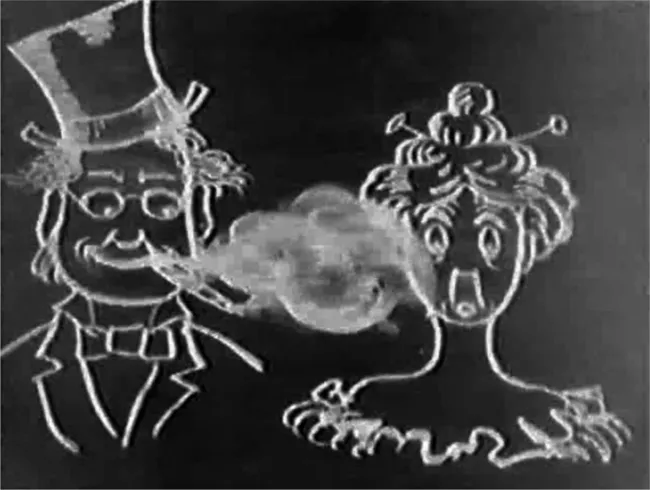
Fig 1.1 J. Stuart Blackton’s Humorous Phases of Funny Faces
Another early pioneer was Emile Cohl, who in 1908 produced Fantasmagorie, which had stick figures morphing into other figures. This has been credited as the first fully animated film. Camera effects started getting more creative (see Figure 1.2).
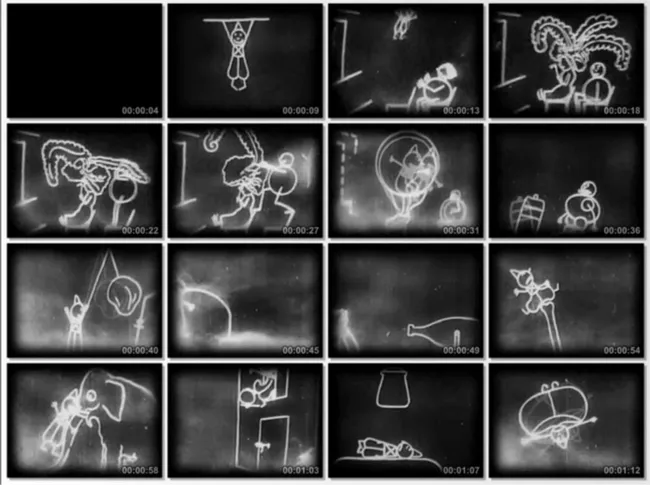
Fig 1.2 Emile Cohl’s Fantasmagorie
Windsor McCay produced perhaps his most famous film in 1914, Gertie the Dinosaur. But he also produced The Sinking of the Lusitania in 1918. The effects that McCay was able to imagine and achieve are, in my opinion, the best that had been done at the time—they would not be matched until the mid- to late-1930s. He truly was head and shoulders ahead of everyone else at the time (see Figure 1.3).
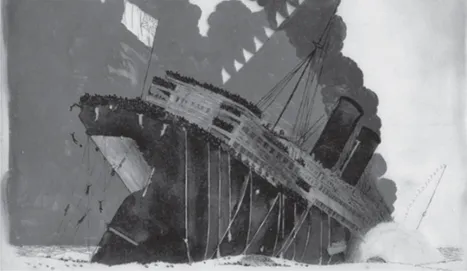
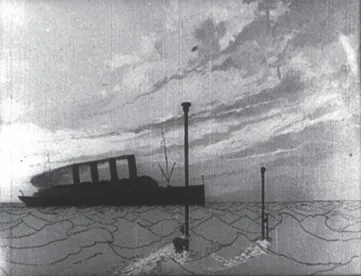
Fig 1.3 Windsor McCay’s The Sinking of the Lusitania
A typical animation desk setup was used in the early days of the animation process until the early 1920s. Windsor McCay set up his animation process like this, using tracing paper and transparent bond, so he could trace his backgrounds with each succeeding drawing (see Figure 1.4). Two holes punched in the paper would hold the paper in place, while the cross marks on the four corners were used to make certain all the drawings would line up as you animated each of the successive ones. You could use one method or the other, or both at once.
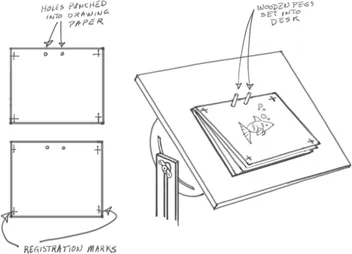
Fig 1.4 Windsor McCay’s animation setup
Meanwhile, within the industry there were advances in the way animation was being handled that advanced the medium. A French Canadian by the name of Raoul Barré and his partner Bill Nolan introduced the “peg” system. This would make it possible to register all drawings in exact alignment with each preceding and succeeding drawing, eliminating any shaking or giggling. The Barré–Nolan team also developed the long horizontal and vertical backgrounds. This would give the characters more freedom to move about the scenes without the need to trace the backgrounds onto each of the character drawings. It made it possible to use multiple layers of animated subjects and to incorporate effects in ways previously not possible, along with the introduction of the “cel system,” attributed to John Randolph Bray and Earl Hurd, who patented the process in 1914. (The cel system consisted of clear celluloid sheets onto which drawings were traced on the front in ink and later painted on the back, filling in the interiors of the silhouetted characters.) Bray is also credited with the system for breaking down the work—the assembly line, if you will, of the layout department, background, animator, assistant, and so on. These innovations, along with the invention of the glass disk in the center of the animator’s drawing board by Vernon George Stallings in the 1920s, further advanced the creative possibilities for animators. Now they could use a back light to see multiple levels at once and get precise one-to-one registration between characters as well as the effects around them (see Figure 1.5).
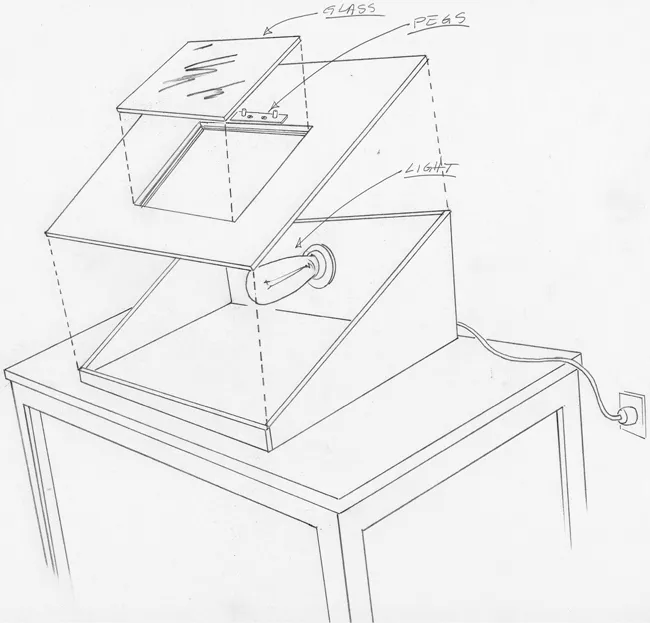
Fig 1.5 1920s animation desk with glass disk and box light
After further innovations to the animation disk, it evolved into the more familiar-looking round disk that the animator could turn and adjust for a more comfortable drawing position. The animation disk had only top pegs until the mid- to late 1930s; the addition of bottom pegs came later and gave the animators the ability to plot pans (see Figures 1.6 and 1.7).

Fig 1.6 More familiar disk with top and bottom pegs
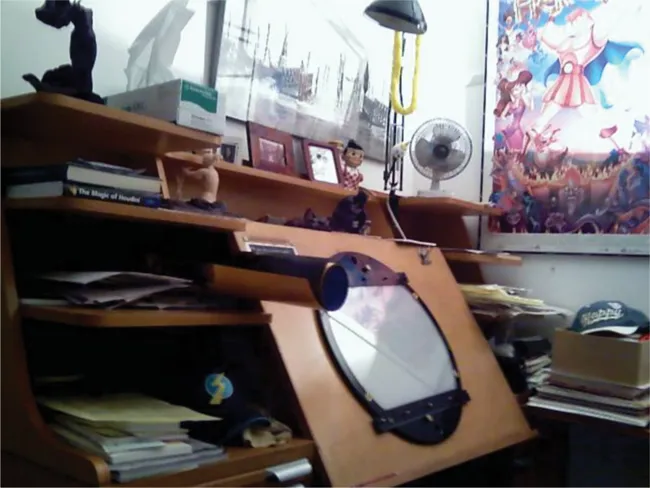
Fig 1.7 My modern-day animation desk at Disney
Animation started to rise to greater heights during the golden age of animation, roughly 1928–1967. Not only did the process get more sophisticated but also the stories got more complex in the telling and the visuals got more intricate. As the character animation became more sophisticated, the effects needed to rise to the occasion if they were to look and feel as if they belonged in the same environment as the characters, in order for the audience to believe that both effects and characters lived in the same environment. Otherwise the contrast would confuse the viewer and undermine the storytelling. In the mid- to late 1930s, a few effects specialists rose out of the character animation ranks. It was the Fleischer Studios and Walt Disney Studios that put more emphasis on the effects in their films. Disney led the way by using the series of shorts he made during that time. Silly Symphonies and the short The Old Mill used some ground-breaking innovations, such as the multiplane camera, that made for some truly memorable imagery. Disney not only used the shorts to train his character animators but also began training a small group of specialists with a knack for special effects. Early on, the Effects Department consisted of two animators and one assistant between them. Cyrus Young and Ugo D’orsi used their unique talents for animating effects to produce some of the best animated special effects ever done (see Figures 1.8 and 1.9).
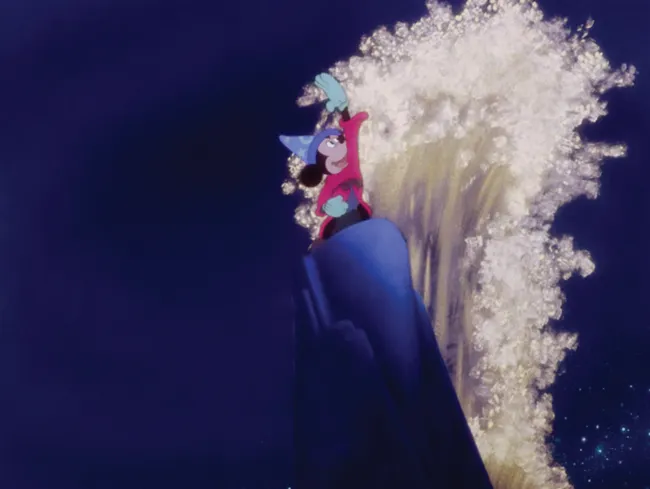
Fig 1.8 “Sorcerer’s Apprentice” from Fantasia, animated by Ugo D’orsi

Fig 1.9 Fantasia, “Blossom Ballerina,” animated by Cyrus Young
These men, along with Josh Meador, who arrived in 1939 and who animated a lot of the water from the Monstro sequence in Pinocchio, raised the bar for...